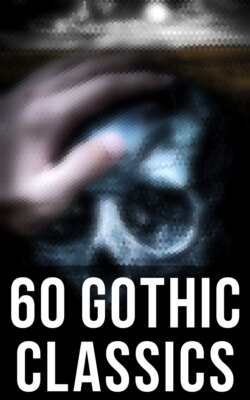Читать книгу 60 Gothic Classics - Эдгар Аллан По, Эмили Бронте - Страница 23
На сайте Литреса книга снята с продажи.
Оглавление133. The pavement, strewed over with saffron There are several circumstances in the Story of the Third Calender, that resemble those here mentioned; particularly a pavement strewed with saffron, and the burning of ambergris and aloes-wood.
134. Ouranbad This monster is represented as a fierce-flying hydra, and belongs to the same class with the rakshe, whose ordinary food was serpents and dragons; the soham, which had the head of a horse, with four eyes, and the body of a flame-coloured dragon; the syl, a basilisk with a face resembling the human, but so tremendous that no mortal could bear to behold it; the ejder, and others. See these respective titles in Richardson’s Persian, Arabic, and English Dictionary.
135. Creatures of clay Nothing could have been more appositely imagined than this compellation. Eblis, according to Arabian mythology, had suffered a degradation from his primeval rank, and was consigned to these regions, for having refused to worship Adam in obedience to the supreme command; alleging, in justification of his refusal, that himself had been formed of ethereal fire, whilst Adam was only a creature of clay.—Al Koran, c. lv, etc.
136. ... the fortress of Aherman In the mythology of the Easterns, Aherman was accounted the Demon of Discord. The ancient Persian romances abound in descriptions of this fortress, in which the inferior demons assemble, to receive the behests of their prince; and from whom they proceed to exercise their malice in every part of the world.—D’Herbelot, p. 71.
137. ... the halls of Argenk The halls of this mighty dive, who reigned in the mountains of Kaf, contained the statues of the seventy-two Solimans, and the portraits of the various creatures subject to them; not one of which bore the slightest similitude to man. Some had many heads, others many arms, and some consisted of many bodies. Their heads were all very extraordinary, some resembling the elephant’s, the buffalo’s, and the boar’s; whilst others were still more monstrous.—D’Herbelot, p. 820. Some of the idols worshipped to this day in Hindostan answer to this description.
138. ... holding his right hand, motionless, on his heart Sandys observes that the application of the right hand to the heart is the customary mode of Eastern salutation; but the perseverance of the votaries of Eblis in this attitude was intended to express their devotion to him both heart and hand.
139. In my lifetime I filled, etc. This recital agrees perfectly with those in the Koran, and other Arabian legends.
140. ... an unrelenting fire preys on my heart Hariri, to convey the most forcible idea of extreme anxiety, represents the heart as tormented by fierce burning coals. This form of speech, it is observed, is proverbial; but do we not see whence the proverb arose?—Chappelow’s Six Assemblies, p. 106.
141. Carathis on the back of an afrit The expedition of the afrit in fetching Carathis is characteristic of this order of dives. We read in the Koran that another of the fraternity offered to bring the Queen of Sheba’s throne to Solomon before he could rise from his place.—Ch. xxvii.
142. ... glanced off in a rapid whirl that rendered her invisible It was not ill conceived to punish Carathis by a rite, and one of the principal characteristics of that science in which she so much delighted, and which was the primary cause of Vathek’s perdition and of her own. The circle, the emblem of eternity, and the symbol of the sun, was held sacred in the most ancient ceremonies of incantations; and the whirling round deemed as a necessary operation in magical mysteries. Was not the name of the greatest enchantress in fabulous antiquity, Circe, derived from κιρκος, a circle, on account of her magical revolutions, and of the circular appearance and motion of the sun, her father? The fairies and elves used to arrange themselves in a ring on the grass; and even the augur, in the liturgy of the Romans, whirled round to encompass the four cardinal points of the world. It is remarkable, that a derivative of the verb, rendered, to whirl in a magical manner (see page 257), which corresponds to the Hebrew סחר, and is interpreted scindere, secare se in orbem, inde notio circinandi, mox gyrandi, et hinc à motu versatili, fascinavit, incantavit, signifies in the Koran the glimmering of twilight: a sense deducible from the shapeless glimpses of objects when hurried round with the velocity here described, and very applicable to the sudden disappearance of Carathis, who, like the stone in a sling, by the progressive and rapid increase of the circular motion, soon ceased to be perceptible. Nothing can impress a greater awe upon the mind than does this passage in the original.
